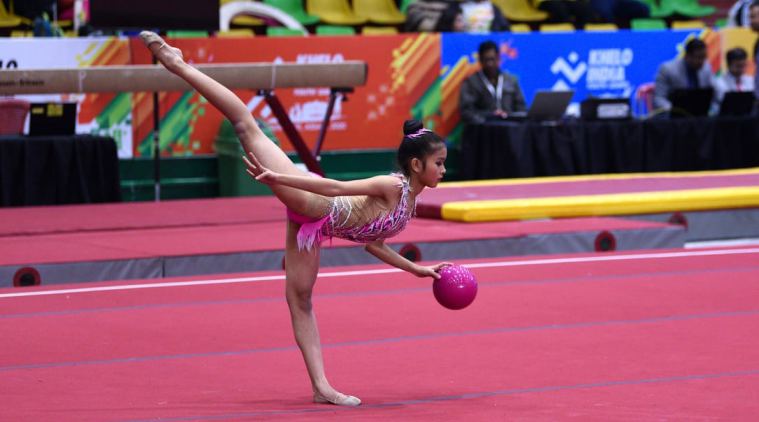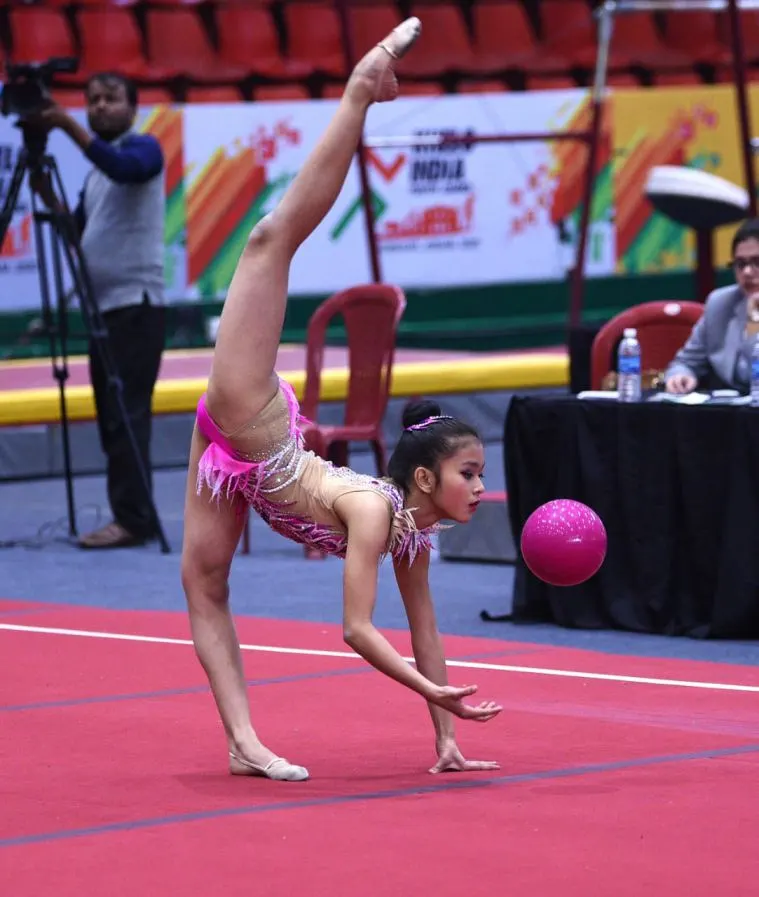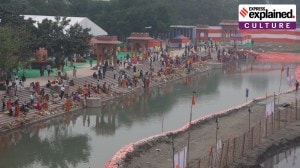No coach, no practice hall – how an Assam teen learnt gymnastics via Skype
How a cross-continental Skype session held together by patchy internet and Google Translate led 12-year-old rhythmic gymnast Upasha Talukdar to win three medals at the recent Khelo India Youth Games in Assam
 12-year-old rhythmic gymnast Upasha Talukdar won three medals at the 2020 Khelo India Games. Photo Courtesy: Khelo India
12-year-old rhythmic gymnast Upasha Talukdar won three medals at the 2020 Khelo India Games. Photo Courtesy: Khelo India
They call her the rubber band girl in school. During homework sometimes, she defies human body physics and uses her big toe to scratch her ear. “How do you even do it?” It’s the one question she gets asked all the time.
Though for 12-year-old rhythmic gymnast Upasha Talukdar — one of the youngest medallists at the 2020 Khelo India Youth Games — it’s something she was born with. “Look at the shape of my arm. See how my feet bend,” she says, gracefully pointing towards her curved elbow, at her home in Guwahati. For anyone else, these might look like oddly-shaped body parts but young Upasha has read up enough on gymnastics to understand that certain physical features give her an inherent knack for the sport, which she picked up when she was 8. Rhythmic gymnastics is a kind of gymnastics that combines dance, callisthenics, acrobatics and ballet, and is performed with a hoop, ball, clubs, ribbon or rope.
In 2016, when she walked up to the gymnasium hall at the Tarun Ram Phookan Indoor Stadium in Guwahati and saw the many gymnasts-in-training, she looked up at her father and said, “I do it at home — that’s easy.” However, her entry into competitive gymnastics has been far from that, and the Class VII student has had to jump through many hoops and hurdles — both inside and outside the gymnasium.
“After initially training in artistic gymnastics, one of the coaches told us that Upasha was fit for rhythmic gymnastics — we did not know what that was but we registered,” says Nikunja Talukdar, Upasha’s father. However, the family soon found that there was no rhythmic gymnastics coach in Assam, or even the Northeast, to train Upasha in the art. “For months, she would just while away hours sitting in the corner of the gymnasium waiting for her turn,” says Talukdar.
It was then that Talukdar — who runs a pharmacy in Guwahati — turned to the internet. A google search of ‘rhythmic gymnastics’ led him to a number of Youtube videos, which his daughter would ‘memorise’ and attempt to imitate back at the gymnasium. “That’s how I learnt the initial exercises,” says Upasha. Her father later took to Facebook as well, to reach out to gymnasts around the world. “The moment I saw someone was a gymnast, I would send a friend request,” he says. And a plea. “I told them that I had a daughter and I needed someone to guide her,” he says.
 Upasha’s training was initially done virtually through Skype. Photo Courtesy: Khelo India
Upasha’s training was initially done virtually through Skype. Photo Courtesy: Khelo India
Over time and several long-winded conversations, Upasha had virtual ‘coaches’ ready to help her from around the world: France, Russia, Australia Uzbekistan, and Georgia. Most were awed by her videos and photographs and some told her she should have been born in Russia — the world’s rhythmic gymnastic hub. One of them was a 16-year-old Russian rhythmic gymnast, Olesya, who decided to “train” Upasha through Skype.
Back then, Upasha had only attended a ten-day basic training camp in Punjab — a result of another one of her father’s Facebook “inquiries”. “Those ten days really helped. Having a real coach instead of watching YouTube videos made a big difference. A coach could actually tell me where I was going wrong,” says Upasha, “But I still did not have a routine.” In gymnastics, a “routine” refers to the choreographed exercise gymnasts prepare in order to participate in professional competitions.
And that is where Olesya’s Skype lessons came in. For it, the hall in Upasha’s home was cleared of all furniture, the computer set up, and a phone, with the Google Translate feature on, kept handy. “We didn’t understand Russian, they did not understand English!” explains Upasha, “But with the help of Google Translate and a very shaky internet connection, we managed.”
Armed with her first professional routine, Upasha signed up for a number of national level junior competitions including the CBSE National Gymnastics (Haryana, 2017), Lakshmibai National Institute of Physical Education games (2018) and the sub-junior games organised by the Gymnastic Federation of India (2018). She won medals in all.
But even as she pranced her way around the national circuit, Upasha had another problem. “We never had a proper space to practise,” says her mother Sewali Deka Talukdar, a paediatrician. “Either the hall wasn’t high enough (rhythmic gymnastics required a high-ceilinged hall since you have to throw a ball), and at other times, it was not free,” she says. Till date, Upasha practises in a varied geography — if one day it is the car parking lot at the stadium, the next could be in a corner of the badminton court. But usually it is in the hall of her own living room. “We briefly got one space we liked at the Bhogeswari Phukanani Indoor Stadium but then again, we did not know if it would be free the next day,” says Talukdar, adding that a former gymnast Shiv Shankar Roy who now works in the Department of Sports & Youth Welfare, Assam, has helped a great deal.
In 2007, Assam’s sole centre for dedicated gymnastics training in Guwahati was demolished and replaced with the multi-purpose gymnasium, the Tarun Ram Phookan Indoor Stadium. Gymnastics training, since then, has been relegated to a space on the fourth floor of the building. “The hall is small and not conducive to proper practice,” says Ghanajyoti Das, one of two gymnastic coaches in Guwahati, “The other problem is the lack of coaches. Between two coaches, we teach 60 gymnasts. The student-coach ratio is 1:10,” he says, adding that they have heard that a new hall dedicated to gymnastics is going to be built soon.
After Upasha was selected to participate in the 2020 Khelo India Youth Games, Arjuna award-winning gymnast and retired coach Kalpana Debnath asked the her to practise in her home in Patiala. “I had never met Upasha but I invited her because even from the videos, I sensed that she had in-born qualities of a world-class gymnast — she is tall, has long arms, long legs, long neck, and is very flexible. However, in-born qualities do not make a champion, training and dedication does. And that is what Upasha needs now,” says Debnath, who hails from Tripura and was a national artistic gymnast in the 1980s.
At the Khelo India Youth Games, Upasha won three (one silver and two bronze) medals in rhythmic all-around competition and in ball and rope routines of gymnastics. “She was the youngest to be competing since there was no under-14 category,” says Debnath. Khelo India, held every year, usually has two categories: under-17 and under-21. “Since Assam was hosting the games this year, Upasha was able to compete,” she says.
Like most aspiring sportspersons, Upasha says her dreams lie in a medal at the Olympics. “Of course, there is a long way to go,” she says. But for now, the young gymnast is hopeful of getting a permanent space to practice in Guwahati. “Many people think rhythmic gymnastics is just a ‘dance’, but it is actually so much more. You need strength, you need balance, you need be flawless — you have to look like you are almost doing magic,” she says.



- 01
- 02
- 03
- 04
- 05




























